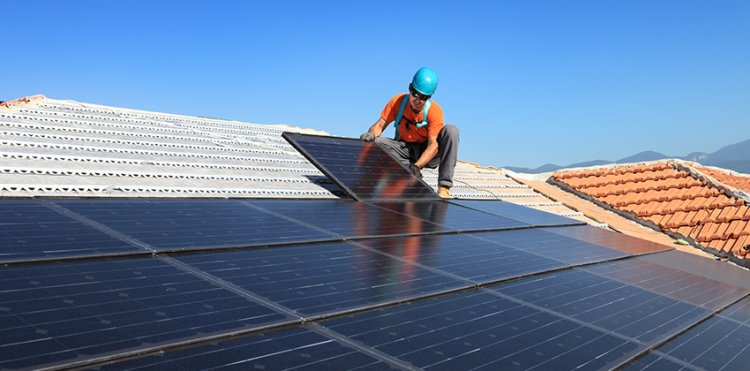Top Innovations in Rooftop Solar Panels This Year
The rooftop solar panels industry has seen remarkable advancements in recent years, with 2024 being a standout year for innovation.
Share this Post to earn Money ( Upto ₹100 per 1000 Views )

The rooftop solar panels industry has seen remarkable advancements in recent years, with 2024 being a standout year for innovation. As solar technology continues to evolve, the latest innovations are pushing the boundaries of efficiency, affordability, and versatility. Here, we delve into the top innovations in rooftop solar panels and how they are transforming the landscape of renewable energy.
1. High-Efficiency Solar Modules
One of the most significant advancements in rooftop solar panels this year is the development of high-efficiency solar modules. These new-generation modules boast efficiency rates exceeding 25%, thanks to breakthroughs in photovoltaic (PV) cell technology. Innovations such as multi-junction cells, which layer multiple semiconductor materials to capture a broader spectrum of sunlight, and advancements in perovskite solar cells, known for their high absorption efficiency, have played a crucial role. These high-efficiency modules enable homeowners to generate more power from the same roof space, making solar energy more viable in areas with limited roof space.
2. Bifacial Solar Panels
Bifacial solar panels, which capture sunlight from both sides of the panel, have gained significant traction this year. These panels can harness reflected sunlight from the roof surface or surrounding ground, increasing overall energy production by up to 30%. The ability to generate power from both the front and rear sides of the panel makes bifacial modules an attractive option for maximizing energy yield, particularly in regions with high albedo surfaces such as snow-covered or sandy areas.
3. Building-Integrated Photovoltaics (BIPV)
Building-Integrated Photovoltaics (BIPV) represent a seamless blend of solar technology and architecture. BIPV systems integrate solar modules directly into building materials such as roof tiles, facades, and skylights. This innovation not only maintains the aesthetic appeal of buildings but also reduces the need for separate mounting structures. Recent advancements in BIPV technology have improved the efficiency and durability of these integrated systems, making them a practical choice for new constructions and renovations.
4. Flexible and Lightweight Solar Panels
This year has also seen the rise of flexible and lightweight solar panels, which are particularly beneficial for installations on unconventional surfaces. These panels are made from thin-film solar cells, which are lighter and more adaptable than traditional silicon-based panels. Their flexibility allows them to be installed on curved surfaces, such as carports, canopies, and even tents, expanding the potential applications of solar technology beyond typical rooftop installations.
5. Smart Solar Panels with Integrated Electronics
Smart solar panels equipped with integrated electronics are another major innovation. These panels come with built-in microinverters or power optimizers, which enhance the overall performance of the solar array. Integrated electronics allow for better monitoring and control of each panel's output, improving system efficiency and reliability. This technology is particularly beneficial in shaded or complex roof environments where individual panel performance can vary significantly.
6. Advanced Energy Storage Solutions
Coupled with the latest rooftop solar panels are advanced energy storage solutions that enhance the utility and reliability of solar power systems. Innovations in battery technology, such as lithium-iron-phosphate (LiFePO4) and solid-state batteries, offer higher energy density, longer life cycles, and improved safety. These storage solutions enable homeowners to store excess energy generated during the day for use during nighttime or cloudy periods, ensuring a continuous power supply and greater energy independence.
7. Enhanced Durability and Weather Resistance
Improving the durability and weather resistance of rooftop solar panels has been a key focus this year. Manufacturers are developing panels with enhanced materials and coatings that can withstand extreme weather conditions, such as hail, heavy snow, and high winds. These advancements extend the lifespan of solar modules and reduce maintenance costs, making solar energy a more reliable and cost-effective option for homeowners.
Conclusion
The innovations in rooftop solar panels this year are driving the solar industry towards greater efficiency, versatility, and integration. High-efficiency solar modules, bifacial panels, BIPV systems, flexible solar panels, smart solar technologies, advanced energy storage, and enhanced durability are all contributing to the rapid adoption of solar energy. As these technologies continue to evolve, rooftop solar panels will play an increasingly vital role in the global transition to sustainable energy, providing homeowners with more efficient, reliable, and aesthetically pleasing solutions for harnessing the power of the sun.






![Smart Hemp Gummies South Africa - [Hidden Truth] Consumer Side Effects Report 2024 and Website Cost](https://blog.rackons.in/uploads/images/202407/image_380x226_6688343942d47.jpg)

